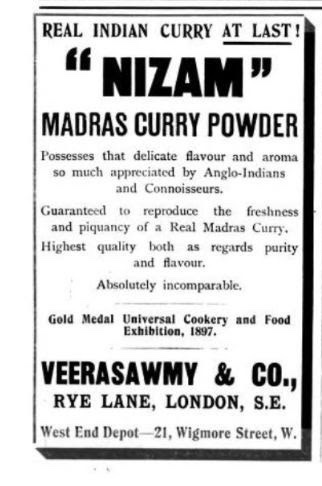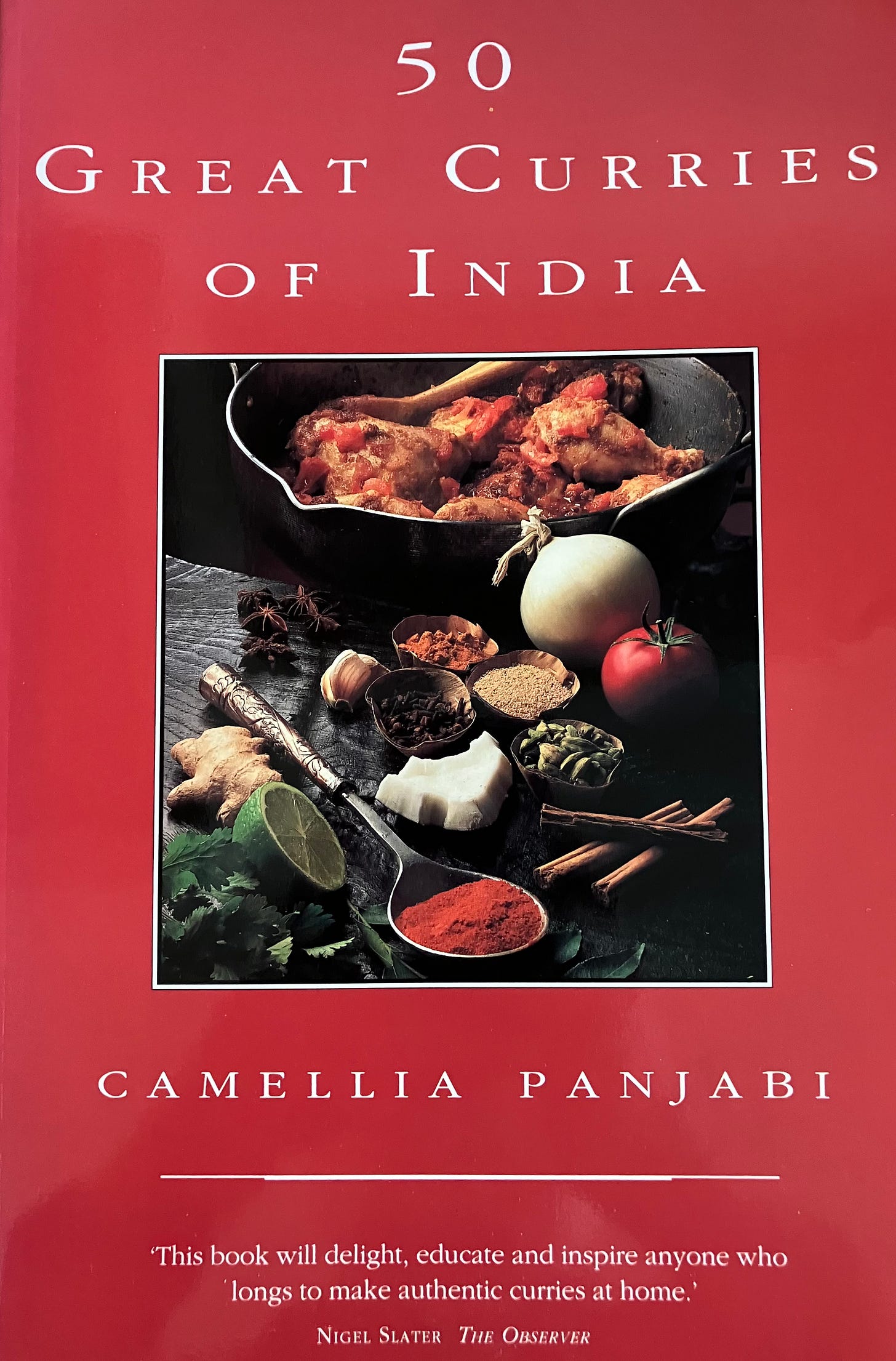Indian Cookery by E.P. Veerasawmy
....The Veeraswamy restaurant, curry powder and a tale of two egg curries.
Age 16, on an early date with the young man that later became my husband, I chose the meat Madras. Faced with an unfamiliar menu it had seemed like a safe choice as the ancient curry powder in mum’s larder said Madras on the label. I thought my face was on fire but was too anxious to let him know how I was struggling. Mum had cooked her curry with sultanas and apple (desiccated coconut and sliced bananas were recommended garnishes back then) but this was a very different experience! .
Somehow I survived that date and we went on to cook together in mum’s kitchen, experimenting with Indian recipes from a book I have long since forgotten.
My university application form invited me to list my hobbies so I quoted ‘cooking curries and .22 rifle shooting’. I was not very good at either but it made for some interesting conversations at interviews with law lecturers. I never completed my legal studies but did embark on a lifetime of collecting recipe books and volumes of food writing.
The books I have accumulated over the years have introduced me to a new world of complexity, a window into the regions of the sub continent, their climate, religions and history. Recently I have particularly enjoyed reading Curry - a tale of cooks and conquerors by Lizzie Collingham which vividly illustrates how the European powers and Britain shaped the history of the sub-continent.
The British soldiers and colonial administrators returning home were nostalgic for the spiced foods they had enjoyed so recipe books from Hannah Glasse in 1747 offered versions of favourite dishes for their cooks. The Hindostanee Coffee House run by Sake Dean Mohamed in fashionable Portman Square was advertising in The Times in 1811, offering authentic curries and a room to smoke hookahs. Merchant seamen, the lascars, from India needed feeding and housing around the ports and many over the years settled and ran restaurants. The poor pay and appalling conditions for the Sylheti boatmen employed stoking the boilers of the steamships meant many chose to stay ashore. These Sylheti men became the key workers cooking, cleaning and serving in ‘Indian’ restaurants even though their homeland had, after partition in 1947, become East Pakistan and later, Bangladesh.
Provincial towns in the 1960s had the usual collection of Indian restaurants with flock wallpaper and pretty identical menus, places to go after the pubs closed and see who dared try the vindaloo.
Scrolling on through the years and it was in the late 1970s, I think, that I ate at Veeraswamy the restaurant that has sat on the first floor above Regent Street since 1926. I can still recall being embarrassed by the almost servile deference of the durwan, the character in a turban and silk costume that escorted us in the lift, the cloakroom attendant and the waiters, the carved elephant stools, Air India mirrors and fancy lights but I don’t remember the food. It is under new ownership now and has a Michelin star. It is an establishment that in itself tells something of the story of Britain and our relationship with the sub-continent and its food. Two of the Indian entrepreneurs who have owned it over the years have written cookbooks.
Who was E.P. Veerasawmy ?
Born 1861 in Hyderabad, he was ‘Anglo Indian’ in the sense that many of his ancestors were of dual heritage, including his grandfather William Palmer the founder of the Palmer banking house of Hyderabad. His great grandfather, General William Palmer, had been confidential secretary to Warren Hastings of the East India Company. He married in 1779 Fais Baksh, a princess of the Royal House of Delhi, and a descendant of the Mughal emperor Shah Jahan, the builder of the Taj Mahal. They are pictured below in an unfinished painting by Zoffany.
E.P. stood for Edward Palmer and he arrived in London with his widowed mother and her family. All the three sons are recorded as medical students and living in Hackney in the 1881 census but is seems he never never qualified. By 1896 he had set up Veerasawmy & Co. in Hornsey, London, to promote Indian food products, ‘so that they could be used under Western conditions and yet produce Eastern results’. Under the trademark ‘Nizam’ they were sold in many stores and grocers in Britain. He went on to cook, lecture and train chefs and then to establish the prestigious Veeraswamy restaurant. He was married three times and had numerous children. It was in 1915, the year his son was killed in World War One, that he produced his book, originally titled Indian Cookery for Use in All Countries. Elsewhere he paid tribute to his mother - ‘ the greatest exponent of Indian cookery.’ It must have sold regularly as my copy is is the fourth paperback edition from Mayflower books, printed in 1969. He died in 1947 and you can find his grave in Friern Barnet cemetery
In his book Edward writes of curry powder that:
In many cases, instead of worrying over the various ingredients, curry powder can be utilised. In my long experience of many years I have used dozens of different curry powders and have come to the conclusion that the Western housewife is not so much to blame as the makers of these so-called Indian curry powders. A genuine Indian curry powder can and does produce a real Indian curry equal to the very finest that can be produced in India …… A really good curry powder that will keep for years, and always produce a perfect curry, is made up of many different seeds, roots and spices, well chosen, well proportioned and well blended, neither too hot or pungent or too vapid and unattractive.
As a salesman of curry powders he would say that, wouldn’t he! However, the majority of his recipes are based on a particular combination of spices and they clearly indicate his heritage in south India with the extensive use of coconut and rice flour, recipes for vindaloos and mulliagatawny.
Camellia Panjabi wrote in 1994:
Curry powder in the form that is now known in the West, was invented in Madras, to be exported to England for use by the English who had become addicted, as we have already seen, to curries. In India spices are used in a highly individual way , and daughters learn learn how to use them by observing their mothers or grandmothers. Each region of India and each sub-cuisine has its own traditional palette of spices ……. Incidentally, contrary to a widely held belief, various forms of curry powder do feature in the traditions of Indian cooking.
She then goes on to say ‘By and large spices are used individually and freshly ground at home’ although mixes do exist such as masala powder in Maharastra. The ‘bottled masala’ made by the East Indian Christian communities of Bombay and Bassein and the balls of curry powder rolled with oil, kaarivadagam, made by Chettiars of Tamil Nadu will both keep for a year.
Camellia Panjabi is now one of the owners of the Veeraswamy restaurant. Born in Bombay, educated in economics at Cambridge, she became the Marketing Director of Taj Hotels operating throughout India and then, in 1982, she set up the Bombay Brasserie in London for that group. With her sister and brother-in-law she now manages MW Eats, running Chutney Mary, Veeraswamy, Amaya and the Masala Zone restaurants.
The Good Food Guide wrote in 2023:
Camellia Panjabi has always been an agent of change. Along with her sister and brother-in-law, she is responsible for igniting a shift in the perception of Indian food in the UK from low-cost, one-flavour-fits-all, post-pub curry to an exciting, nuanced cuisine, inflected with the scope of flavours of the sub-continent, and deserving of the same respect as the finest classical cookery. This year’s Lifetime Achievement recipient in CODE Hospitality’s annual Women of the Year Awards ….
She describes in the introduction to her book how the repertoire of hotels and restaurants throughout India has been dominated by the Punjabi dishes the customers expect to see. In contrast, it has proven easier in recent years to introduce menus of regional Indian specialities in Britain.
As The Good Food Guide says:
Camellia paved the way for a raft of superstar chefs such as Atul Kochhar, Vivek Singh, Vineet Bhatia and Aktar Islam. Could acclaimed restaurants such as Tamarind and Cinnamon Club (2001), Benares (2003), or more recently Opheem (2018), Pahli Hill (2020) and Bibi (2021) have opened were it not for Camellia and her questioning, determined ways? Arguably not.
Edward and Camellia, two entrepreneurs, have together changed the way we think about the food of India.
Paid subscribers can read on to discover the secret of their egg curry recipes - perhaps not a pretty dish but can be simple and nutritious.








